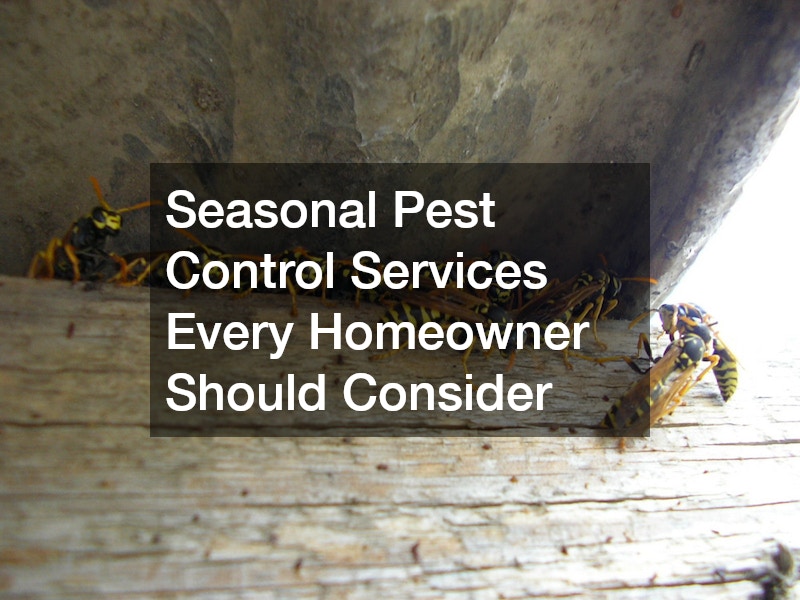Seasonal pest control is a crucial aspect of maintaining a household’s comfort and well-being throughout the year. As each season brings distinct changes in weather patterns, it also ushers in specific pests that can affect the integrity of homes and the health of families. By scheduling pest control services tailored to each season, homeowners can prevent infestations, minimize damage, and enjoy the long-term benefits of a pest-free environment.
The Most Common Seasonal Pests
Spring Pests
Spring is a time of renewal, not just for nature but also for pests such as ants, termites, and bees. These insects emerge as temperatures rise, seeking out new habitats and food sources, often finding their way into homes during this transition.
Ants can invade en masse searching for sugary and greasy substances, while termites become active, potentially causing significant structural damage if not controlled promptly.
The emergence of bees in spring is also common, as they play an essential role in pollination, but their nesting habits can pose risks. Carpenter bees, for example, bore into wood to lay eggs, potentially damaging wooden structures around homes. Effective pest control can address these issues by implementing barriers and treatments that deter these insects from settling near residential areas.
Summer Pests
Summer is synonymous with outdoor activities, but it is also the peak season for pests like mosquitoes, flies, and wasps. Warm temperatures and high humidity provide ideal breeding conditions for mosquitoes, leading to increased numbers and a higher risk of associated diseases. Flies also thrive in summer, attracted by food and waste, often becoming a nuisance during outdoor gatherings.
Wasps, while helpful pollinators, are more aggressive in summer as they establish colonies and search for food. Their stings can be painful and potentially dangerous, especially for individuals with allergies. Pest control services during summer focus on reducing these populations through targeted treatment and habitat disruption.
How Pest Control Services Vary by Season
Seasonal Strategies
Pest control strategies are as varied as the seasons themselves, with each requiring a unique approach to manage the predominant pests. In spring, services focus on early intervention to address breeding populations of ants and termites, often involving preventative soil treatments and barrier applications. Summer strategies, however, intensify around mosquito control, utilizing barriers and natural repellents.
Autumn brings its own challenges, requiring strategies that focus on sealing entry points and removing attractants to deter rodents and spiders seeking shelter from cooling temperatures. Winter services often involve monitoring and maintaining existing deterrents, ensuring that pests do not find warmth within cozy homes. By tailoring tactics to match seasonal pest behaviors, pest control professionals provide effective protection year-round.
Preventative vs. Reactive Services
Preventative pest control aims to reduce the likelihood of infestations before they occur, employing measures like regular inspections, structural repairs, and landscape management. Reactive services, in contrast, address active infestations, often involving immediate treatments and follow-up applications to ensure elimination. The balance between these services is a key feature of effective seasonal pest management.
During each season, pest control experts assess the unique risks associated with prevalent pests and recommend preventative actions tailored to their life cycles. This proactive approach may include setting traps, applying eco-friendly barriers, and educating homeowners about minimizing attractants. However, when infestations occur, reactive measures are essential to promptly address and control the pest population.
The Costs and Benefits of Seasonal Pest Control
Cost Analysis
The cost of seasonal pest control services varies based on factors such as location, the severity of infestations, and the types of pests involved. On average, homeowners can expect to invest in regular inspections and treatments that address specific seasonal pest threats, with some companies offering package deals or discounts for ongoing contracts. These costs, while an additional household expense, are often justified by the benefits of proactive pest management.
Different service providers may adjust their pricing structures based on the complexity of the treatment required and the resources involved in managing particular pests. Seasonal discounts may also be available, incentivizing homeowners to commit to continuous services rather than sporadic reactivity. Investing in consistent pest control ensures that preventative strategies are employed, reducing the likelihood of costly exterminations down the line.
Long-term Benefits
Long-term benefits of seasonal pest control include protection of property value, prevention of health issues, and overall improvement of living conditions. A well-managed pest control system ensures that homes remain safe from destructive pests like termites, which can cause costly structural damage if left unchecked. Beyond property protection, pest control also reduces exposure to health hazards associated with pests such as mosquitoes, known carriers of diseases.
Regular pest control services also foster a cleaner and more pleasant living environment by minimizing the presence of nuisance pests like flies and ants. Families can enjoy their living spaces without the disruptions that come with battling household pests. By investing in year-round prevention and treatment, homeowners also enjoy a long-term reduction in the time and effort typically spent on DIY pest management.
Incorporating seasonal pest control services into routine home maintenance offers numerous advantages for homeowners, from improved safety to financial savings. By understanding the cyclical nature of pest activity, homeowners can work with pest control professionals to implement effective strategies that support a healthy, comfortable living environment. As the seasons change, so too should the tactics employed, ensuring that homes remain sanctuaries, free from the intrusion of unwanted pests year-round.

